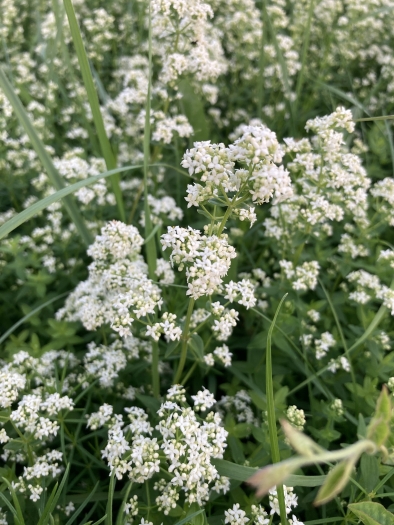Northern Bedstraw
(Galium boreale)
Northern Bedstraw (Galium boreale)
/
/

Stanislav Murashkin
CC BY 4.0
Image By:
Stanislav Murashkin
Recorded By:
Copyright:
CC BY 4.0
Copyright Notice:
Photo by: Stanislav Murashkin | License Type: CC BY 4.0 | License URL: http://creativecommons.org/licenses/by/4.0/ | Rights Holder: Stanislav Murashkin | Publisher: iNaturalist | Date Created: 2023-07-18T16:44:17Z |
























Estimated Native Range
Summary
Galium boreale, commonly known as Northern Bedstraw, is a perennial herb native to a variety of habitats including moist meadows, grasslands, forest clearings, and along streams in temperate to subarctic regions of Europe, Asia, and North America. It is particularly prevalent throughout most of Canada and the northern United States. Northern Bedstraw typically grows 8 to 20 inches tall and features whorled leaves, usually in groups of four, which resemble the spokes of a wheel. From late spring to early summer, it produces small, fragrant white flowers in dense, showy panicles that are attractive to pollinators.
Northern Bedstraw is valued for its ability to form extensive colonies through rhizomes, making it useful for soil stabilization and as a ground cover in restoration projects and naturalized areas. It is also appreciated for its historical use in traditional bedding, where its pleasant scent was thought to deter fleas, and for its use in dyes. In cultivation, it prefers full sun to partial shade, moist but well-drained soils, and is relatively low maintenance. However, it is listed as endangered in Maryland and Massachusetts, indicating a need for conservation efforts in those areas. While generally not prone to serious pests or diseases, it can become sparse in overly dry conditions.CC BY-SA 4.0
Northern Bedstraw is valued for its ability to form extensive colonies through rhizomes, making it useful for soil stabilization and as a ground cover in restoration projects and naturalized areas. It is also appreciated for its historical use in traditional bedding, where its pleasant scent was thought to deter fleas, and for its use in dyes. In cultivation, it prefers full sun to partial shade, moist but well-drained soils, and is relatively low maintenance. However, it is listed as endangered in Maryland and Massachusetts, indicating a need for conservation efforts in those areas. While generally not prone to serious pests or diseases, it can become sparse in overly dry conditions.CC BY-SA 4.0
Plant Description
- Plant Type: Shrub, Herb
- Height: 0.75-1.3 feet
- Width: 1-1.5 feet
- Growth Rate: Moderate
- Flower Color: N/A
- Flowering Season: Spring, Summer
- Leaf Retention: Semi-deciduous
Growth Requirements
- Sun: Full Sun, Part Shade
- Water: Medium
- Drainage: Fast, Medium
Common Uses
Bee Garden, Low Maintenance, Rabbit Resistant
Natural Habitat
Moist meadows, grasslands, forest clearings, and along streams in temperate to subarctic regions
Other Names
Common Names: White Bedstraw, Bedstraw
Scientific Names: , Galium boreale, Aparine borealis, Aparine borealis, Galium auriense, Galium auriense, Galium boreale f. genuinum, Galium boreale f. humidiusculum, Galium boreale f. hyssopifolium, Galium boreale f. kamtschaticum
GBIF Accepted Name: